Poultry
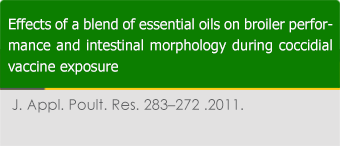 |
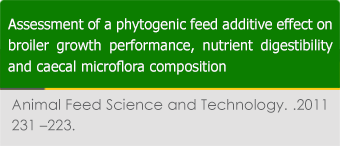 |
|
|
N. Reisinger, T. Steiner, S. Nitsch, G. Schatzmayr, and T. J. Applegate A 2 × 2 factorial experiment (8 pens/treatment, 26 birds/pen) was conducted with 2 doses of a coccidial vaccine [1× or 5× (Paracox-5, Schering-Plough Animal Health, Uxbridge, UK)], administered at 1 d of age) with or without supplementation (125 g/1,000 kg) with a phytogenic feed additive containing a blend of essential oils from oregano, anise, and citrus peel [Biomin P.E.P. 125 poultry (Biomin GmbH, Herzogenburg, Austria); EO]. Within each pen, 13 birds received the coccidial vaccine, whereas the remainder were naturally exposed through the recycling of oocysts in the litter. In pens of birds receiving the higher (5×) dosage of coccidial vaccine, the BW of broilers decreased by up to 2.7% (P = 0.08), but feed-to-gain ratio (FCR) and mortality at 27 d of age (P > 0.05) were not affected. Between d 14 and 27 within pens of birds receiving the 1× dosage of coccidial vaccine, those that were fed EO had a 5.6% increase in BW gain (P < 0.05). Supplementation with EO did not affect feed intake or FCR (P > 0.05). Birds naturally exposed in pens receiving the higher (5×) dosage of coccidial vaccine had an 11% reduction in ileal crypt depth (P < 0.05) and a 19% quicker enterocyte turnover rate (P = 0.086), but there was no effect on ileal villus length or number of goblet cells (P > 0.05). In naturally exposed birds with pen-mates given the 1× dosage of coccidial vaccine, birds fed EO had 12% longer villi than did unsupplemented birds (P < 0.05), with 30% more goblet cells and 23% more goblet cells/10 μm of villus length (P < 0.05). In conclusion, the dosage of coccidial vaccine had an impact on BW, intestinal turnover rate, and crypt depth, whereas dietary supplementation with the EO additive increased villus length and goblet cell density, which may have created an improved barrier against pathogens during a mild coccidial exposure. -- ---- - - ------- ---- -- - - - - - - --- - - - ---- - - - - -------- ------------- --- - ------------ ---- - - - - - - - - - - - - - ----- ------ - - - - - - ------- ---- ---- - - -- - - -- -- ------- ------- - - - - ----- - - -- - - -- -- ------- ------- - - - - -- --- - ------------ ---- - - - - - - - - - - - - - ----- ------ - - - - - - ------- ---- ---- - - -- - - -- -- ------- ------- - - - - ----- - - -- - - -- -- ------- ------- - - - - -- --- - ------------ ---- - - - - - - - - - - - - - ----- ------ - - - - - - ------- ---- ---- - - -- - - -- -- ------- ------- - - - - ----- - - -- - - -- -- ------- ------- - - - - -- --- - ------------ ---- - - - - - - - - - - - - - ----- ------- - - - - - |
K.C. Mountzourisa, V. Paraskevas, P. Tsirtsikos, I. Palamidi, T. Steiner, G. Schatzmayr, K. Fegeros The aim of this work was to evaluate the effect of three inclusion levels of a phytogenic feed additive (PFA) comprising a blend of essential oils from oregano, anise and citrus on broiler growth performance, nutrient digestibility and caecal microflora composition. Five hundred and twenty-five, 1-day-old, male Cobb broilers received a maize–soybean meal basal diet (BD) and depending on the type of addition were allocated in the following five experimental treatments for 6 weeks: BD–no additives (C), BD containing 80 mg PFA/kg diet (E1), BD containing 125 mg PFA/kg diet (E2), BD containing 250 mg PFA/kg diet (E3) and BD containing avilamycin at 2.5 mg/kg diet (A). Treatment A was used as a positive control due to the well-known function of avilamycin as an antimicrobial growth promoter in poultry. Overall broiler body weight gain (BWG) increased linearly (P=0.039) with increasing PFA level, however, the avilamycin treatment A did not differ (P≥0.05) from the PFA and C treatments. Overall feed intake (FI) decreased quadratically (P=0.046) with increasing PFA level, while the FI for treatment A did not differ from the rest of the treatments. The overall gain:feed ratio improved linearly (P<0.001) with increasing PFA level and treatment A (0.57) did not differ from E2 (0.58) and E3 (0.58) but it was significantly (P<0.05) better compared to E1 (0.54) and C (0.54). The PFA level had a marginal linear (P=0.059) and a significant (P=0.021) quadratic effect on the total tract apparent digestibility (CTTAD) of organic matter (OM) and the nitrogen corrected apparent metabolisable energy (AMEn) of experimental diets, respectively, with treatment E1 having the higher (P<0.05) CTTAD of OM (0.79) and AMEn (13.4 MJ/kg diet) and treatment A being not different from the four other treatments. On the other hand, the avavilamycin treatment A had a significantly (P<0.05) higher coefficient of ileal apparent digestibility (CIAD) of fat (0.70) as well as CTTAD of ash (0.53) and fat (0.77) compared to the PFA treatments and C. There was a linear increase of caecal Lactobacillus (P=0.002), Bifidobacterium (P=0.001) and Gram positive cocci (P=0.007) concentration with increasing PFA level at 42 d old broilers. In addition, caecal coliforms at 14 d old broilers were significantly (P<0.05) lower in treatments E2 and E3 compared with A. |
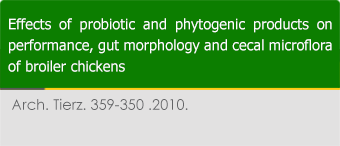 |
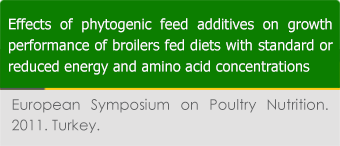 |
|
|
L. Peric, N. Milosevic, D. Zikic, S. Bjedov, D. Cvetkovic, S. Markov, M. Mohnl and T. Steuner The trial involved 684 Cobb 500 broiler chicks in order to investigate the effects of probiotics and phytogenic additives on performance, gut morphology and cecal microbial concentrations. Birds were assigned to three treatments: control feed, treatment with addition of probiotics in feed and water and treatment with addition of phytogenic blend in feed. The results showed a significant improvement (P<0.01) in body weight gain and a numerical, but non significant (P>0.05) improvement in feed conversion ratio by adding both probiotics and phytogenics in feed. There were no statistically significant differences among treatments regarding total aerobes, anaerobes, lactic acid bacteria, bifidobacteria, enterococci, and Escherichia coli populations (P>0.05) in cecum of broilers. The gut morphology examination showed that probiotics had beneficial effect on jejunum morphology causing a significant (P<0.005) increase in villus height and villus surface area compared to other two groups. On the other hand, phytogenic additive had no effect (P>0.05) on villus height or villus surface area, but reduced the villus/crypt ratio (P<0.05), which may indicate that the improved production results in the group with added phytogenics are not directly connected with changes in gut integrity, but with other physiological mechanisms. ---------------- ----- --------- ---- --------- ---- ---- --- -- ---- --- ---- ---- ----- --- --- --- ---- -- -- --- ---- ----- ------ ----- ------ - - - - - - - - |
Tobias Steinera, Lidija Peric, Sinisa Bjedov, Niko Milosevic The effects of dietary supplementation with two phytogenic feed additives (PFA) on performance parameters were investigated using 1200 mixed sex broilers fed standard diets or diets with reduced energy and amino acid concentrations. Birds were assigned to 6 treatments with 5 replications each and either fed a standard basal diet or a re-formulated basal diet with 1.5% reduced energy and amino acid concentrations. Treatments were: (1) Standard diet; (2) as 1 + PFA-1; (3) as 1 + PFA-2; (4) Re-formulated diet; (5) as 4 + PFA-1; (6) as 4 + PFA-2. PFA-1 was a blend of essential oils from oregano, anise and citrus adsorbed to an organic carrier (dosage: 0.125 g/kg) and PFA-2 was blend of essential oils from oregano, thyme, anise and citrus, encapsulated in a carbohydrate matrix (dosage: 0.1 g/kg). Live weight was affected by diet (standard vs. re-formulated) at 14 (p<0.05) and 42 days of age (p<0.01). Supplementation of the standard diets with both PFAs increased (p<0.05) live weight at 42 days. Throughout the experiment live weight of birds fed the re-formulated diets was numerically lower compared to birds fed the standard diet, being significantly lower (p<0.05) at 14 days. Mortality and FCR did not differ between treatments. In conclusion, moderate reformulation of diets for energy and amino acids reduced broiler growth rates. Furthermore, supplementation of the diets with PFA improved live weight, hence confirming a growth promoting effect of essential oils in broilers. |
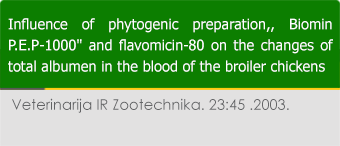 |
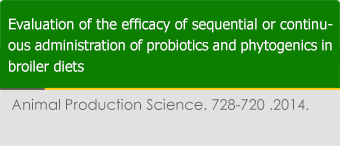 |
|
|
Sirvydis v., Sabalionyte R., Bobiniene R., Gruzauskas R. The aim of the research is to investigate the influence of phytogenic preparation „Biomin P.E.P – 1000“, which is of a natural origin, on the processes of albumen metabolism in the organism of broiler chickens. Biomin P.E.P – 1000 positively stimulates the activity of the alimentary tract of broiler chickens as well as a composition of intestine micro flora, consequently that conditions better digestion of nutrient substances. 3 groups of broiler chickens were researched. The chickens of the first group were fed with the feed mixture, containing a feeding antibiotic Flavomicin-80, in the feed of the second group of chickens a feeding antibiotic Flavomicin – 80 was replaced by a dry phytogenic preparation „Biomin P.E.P–1000“, and in the drinking water of the chickens of the third group a liquid phytogenic preparation „Biomin P.E.P-1000“was added. The results of the research showed that under the influence of „Biomin P.E.P–1000“a total amount of nucleic acids and albumen in the blood of chickens increased. It was defined that a dry phytogenic preparation Biomin P.E.P – 1000 was more effective than a liquid one. Compared to the first group, in the blood of the chickens at the age of 42 days a total amount of nucleic acids increased from 22.6% to 26.5%, and the amount of albumen increased from 12.5% to 22.6%. A phytogenic preparation „Biomin P.E.P–1000“stimulated the growth of chickens. The greatest increase of live weight was in group 2, the weight of male-chickens increased by 13.81% (P<0,001) and the weight of female-chickens increased by 7.08% (P<0,001), compared to the first group, where a feeding antibiotic Flavomicin-80 was used. - - - -- - - -- -- ------- ------- - - - - ----- - - -- - - - - - - - - - - - - - - ----- ------ - - - - - - ------- ----
|
K. C. Mountzouris, P. Tsirtsikos, G. Papadomichelakis, G. Schatzmayr and K. Fegeros Three dietary combinations of probiotics and phytogenics administered sequentially or continuously were assessed for their effects on broiler performance, nutrient digestibility, caecal microbiota composition, volatile fatty acid (VFA) pattern and plasma total antioxidant capacity (TAC). One-day-old Cobb male broilers (n = 525) were allocated to five experimental treatments for 42 days. Each treatment had three replicates of 35 broilers each. Depending on the time-frame of sequential or continuous addition in the basal diet (BD) of the probiotics (108 CFU/kg BD) and phytogenics (125 mg/kg BD), experimental treatments were: control (no additions, Days 1–42); PE1, probiotic Days 1–14 and phytogenic Days 15–42; PE2, probiotic Days 1–28 and phytogenic Days 29–42; PE3, probiotic and phytogenic continuously (Days 1–42); and A (2.5 mg avilamycin/kg diet, Days 1–42). There was no loss of probiotic viability upon mixing with the phytogenic for up to 7 days. Overall bodyweight gain was higher (P = 0.025) in the control and PE1 than PE2 and PE3, whereas Treatment A was intermediate and not different from the rest. Overall feed intake in the control was the highest (P = 0.003). Treatments PE1, PE2 and PE3 had better (P = 0.004) overall feed conversion ratio (FCR) than the control. The FCR in PE1 and PE3 did not differ from A, which had the best FCR. Mortality did not differ among treatments. Nutrient digestibility and caecal microbiota composition did not differ among treatments. However, differences (P ≤ 0.05) in caecal VFA pattern were noted, with the control having the lowest acetate molar ratio as well as the highest sum of valeric, hexanoic and heptanoic acids. Plasma TAC in the control was lower than in PE3, PE1 and PE2 at Day 14 (P < 0.001) and PE1 (P = 0.003) at Day 42. The concept of sequential or throughout probiotic and phytogenic administration showed promising results regarding feed efficiency and plasma TAC. |
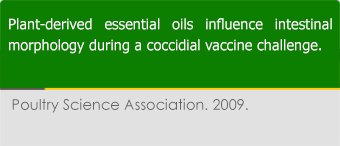 |
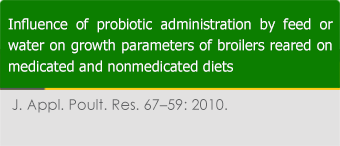 |
|
|
N. Reisinger, T. Steiner, S. Nitsch, G. Schatzmayr, and T. J. Applegate Because of pending and current regulations, the poultry industry is searching for alternatives to growth promoting antibiotics which may include plant-derived supplements which may prevent or lessen the severity of coccidiosis. Therefore, a 2 x 2 experiment (8 pens / treatment, 26 birds / pen) was conducted with 2 doses of a coccidial vaccine (1X or 5X; Paracox® 5 administered at 1 d of age) with or without supplementation (125 g/1000 kg) with a phytogenic feed additive containing essential oils from oregano, anis and citrus peel (Biomin®P.E.P. 125 poultry). Within each pen, 13 birds received the coccidial vaccine while the remainder was naturally infected through recycling of oocytsts in the litter. One of the naturally infected birds/pen was euthanized for histological evaluation of the mid-ileum morphology while 5/pen were collected for determination of apparent digestible energy, nitrogen, and mucin content from ileal digesta. The higher (5X) dosage of the coccidial vaccine resulted in an 11% reduction in crypt depth (P < 0.05), but there was no effect on villius length or number of goblet cells (P > 0.05). The dosage of coccidial vaccine had no effect on the apparent digestibility of energy or nitrogen. At Paracox® 1X dosage, birds fed the phytogenic feed additive had 12% longer villi than the control fed birds (P < 0.05) with 30% more goblet cells, and 23% more goblet cells per 10 microns villius length (P < 0.05). Neither coccidial vaccine dosage nor phytogenic supplementation influenced ileal mucin content (concentration or per unit of feed intake). Birds fed the phytogenic feed additive at a Paracox® 5X dosage had 4% less apparent digestible energy (P < 0.05), however at the Paracox® 1X dosage there was no effect of the phytogenic feed additive (P > 0.05). In conclusion, the dosage of coccidial vaccine can have an influence on the crypt depth and supplementation of the diet with a phytogenic additive increased villi length and goblet cell density. |
Eckert, N. H., J. T. Lee, D. Hyatt, S. M. Stevens, S. Anderson, P. N. Anderson, R. Beltran, G. Schatzmayr, M. Mohnl, and D. J. Caldwell Two separate performance trials were conducted to determine the effects of postpelleting feed or drinking water application of a Lactobacillus-based probiotic, alone or in combination with a phytogenic product, on growth parameters of broilers fed medicated or nonmedicated diets. Trial 1 consisted of 1,000 straight-run broilers that were randomized, placed in floor rearing pens, and fed medicated diets. At the conclusion of the experiment, BW of broilers receiving the probiotic were not different (P > 0.05) when compared with control broilers. In trial 2, stocking densities were increased to simulate local industry rearing practices, resulting in a total placement of 1,880 chicks in the same rearing facility. Broilers in trial 2 were fed nonmedicated diets. Broilers administered the probiotic by intermittent drinking water application had increased (P < 0.05) BW and improved FCR (P < 0.05) through d 40 compared with control birds. Similarly, broilers receiving the phytogenic product had reduced (P < 0.05) FCR at d 40 compared with control broilers. We conclude that probiotic administration, alone or in combination with a phytogenic product, has the potential to influence broiler performance during commercial grow-out.
|
 |
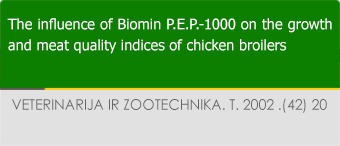 |
|
|
Priudokiene, V., D. Gudaviciute The effect of phytogenic preparation Biomin P.E.P.-1000 on the growth of chicken broilers was analysed. The active component of Biomin P.E.P.-1000 is a herbal formula consisting of phytobiotics and polyfructosans. All active substances in this preparation are of plant origin, which do not cause antibiotic resistance and do not leave residues in animal products. The investigation was carried out with broilers Cross Hibro-G at 1 - 42 days of age in Poultry Farm “Vilniaus paukštynas” and in the Research Laboratory of Biological Diversity and Technologies, Vilnius Pedagogical University. The experiment was held with three groups of broilers and every group contained 100 chickens. The chickens of the control group received antibiotic Flavomicin-80 in their diet. The chickens of the other two groups received the same diet (the same ingredients and nutritiveness) as the control group, but antibiotic Flavomicin-80 of the second group was replaced by phytogenic preparation Biomin P.E.P.-1000 in dry powder form and the chickens of the third group received the water supplemented with liquid Biomin P.E.P.-1000. The breeding conditions were the same for all the groups. The data of the investigation lead to the conclusion that under the influence of phytogenic preparation Biomin P.E.P.-1000 the live weight of chickens of the experimental groups at the age of 42 days was higher 4.87 – 14.55 %, compared with the control group. Under the influence of this preparation the output of slaughter was 0.52 – 1.81 %, of edible parts – 1.60 - 2.15 % and the output of muscles of the experimental broilers groups was 1.52 - 2.70 % higher, compared with the control group. The chemical analyses of broilers meat showed, that under the influence of phytogenic preparation Biomin P.E.P.-1000 the amount of dry matter and albumen was found respectively by 0,17 – 0,31 % and 0,66 – 0,76 % higher in the breast muscles of male and by 0,61 – 1,53 % and 1,26 - 1,55 % higher of female chicks. |
 Digestarom P.E.P
Digestarom P.E.P